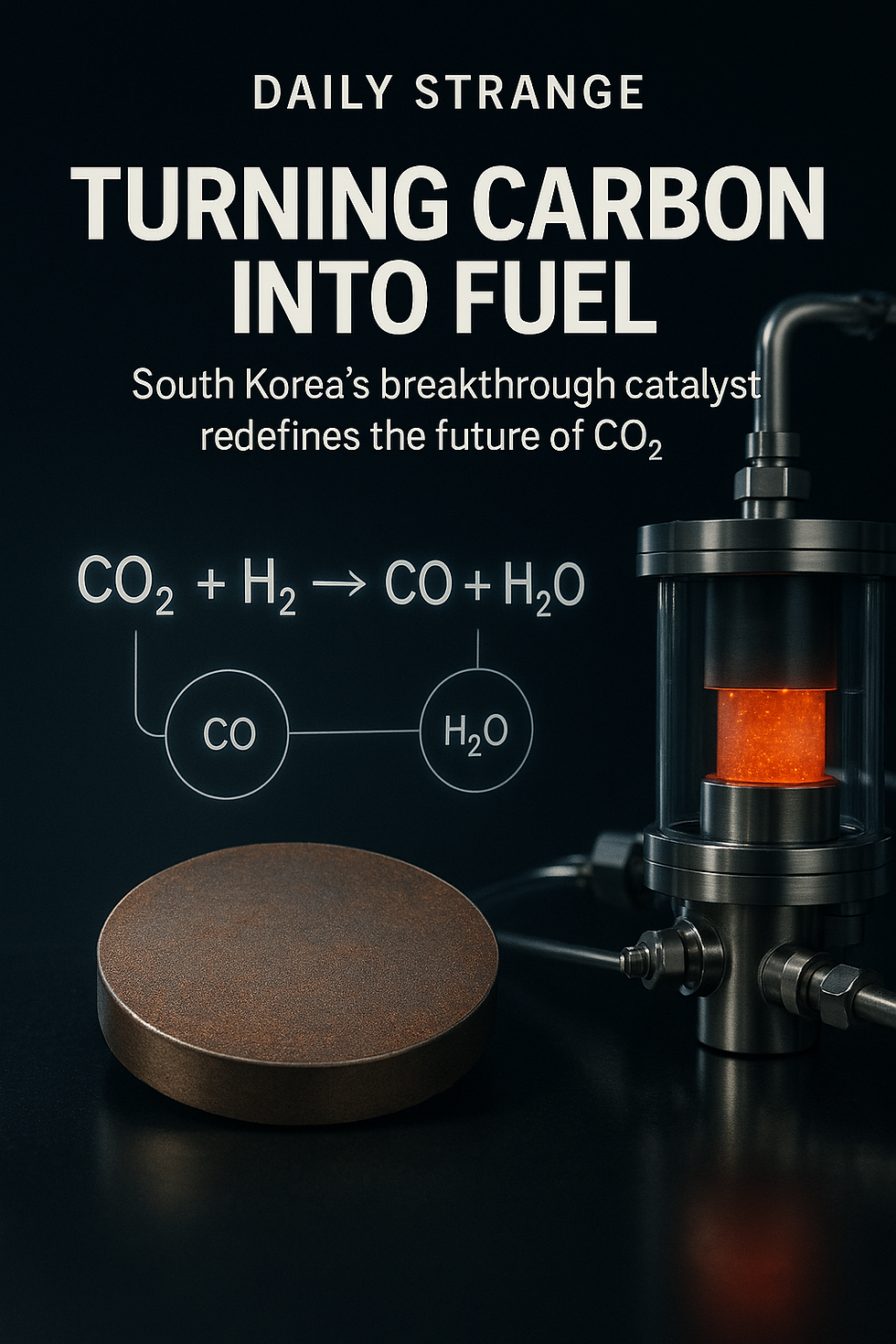Turning Carbon Into Fuel: South Korea’s Breakthrough Catalyst Redefines the Future of CO₂
- Daily Strange

- Nov 6
- 3 min read
In a world choking on its own progress, one of humanity’s greatest paradoxes has always been this: the same gas that sustains life — carbon dioxide — is the one that’s slowly suffocating it. Yet, in a quiet laboratory in Daejeon, South Korea, a team of scientists may have just found a way to turn this paradox into power.
Researchers from the Korea Institute of Energy Research (KIER) have unveiled a revolutionary copper–magnesium–iron (Cu–Mg–Fe) catalyst capable of converting carbon dioxide (CO₂) into carbon monoxide (CO) — a key building block for creating synthetic fuels — without the need for extreme temperatures.
This seemingly small scientific step could, if scaled, transform the carbon cycle as we know it.
The Science Behind the “Reverse Fire”
At the heart of this discovery lies a process known as the Reverse Water–Gas Shift Reaction (RWGS) — a method that takes CO₂ and hydrogen (H₂) and rearranges their molecular bonds:
CO₂ + H₂ → CO + H₂O
The resulting CO (carbon monoxide) can then be used to create syngas, the essential feedstock for producing synthetic fuels like methanol, e-fuels, and other carbon-neutral energy sources.
What makes this discovery so striking is efficiency. Traditional RWGS reactions require extremely high temperatures, often beyond 700°C, consuming massive amounts of energy. The new Cu–Mg–Fe catalyst achieves remarkable conversion rates at far lower temperatures, cutting both cost and energy consumption.
Dr. Kim Do-hyun, one of the lead researchers, described the breakthrough as “a step toward a circular carbon economy where CO₂ is no longer waste, but wealth.”
Why It Matters
Imagine burning fuel that doesn’t add new carbon to the atmosphere — instead, it recycles the CO₂ that’s already there. That’s the dream of a carbon-neutral energy cycle, and this new catalyst brings it closer than ever.
1. Environmental Impact
Instead of releasing CO₂ as an industrial byproduct, factories could capture it, feed it into this catalytic process, and create usable fuels. The result? A closed-loop system where emissions fuel the next wave of energy production.
2. Economic Shift
Carbon capture is expensive and often criticized as impractical. But if CO₂ becomes a valuable raw material, its capture becomes a financial opportunity rather than a burden. Imagine carbon trading markets where the waste gas becomes a currency.
3. Energy Independence
The process relies on hydrogen — ideally “green hydrogen” produced via renewable-powered electrolysis. This synergy between hydrogen energy and CO₂ conversion could redefine the global energy map, particularly for countries with limited fossil reserves but high renewable capacity.
The Challenges Still Ahead
Every scientific miracle comes with its shadows. The Cu–Mg–Fe catalyst, while efficient in the lab, must still prove itself at scale.
Industrialization means exposure to impurities, fluctuating pressures, and long-term degradation — all factors that could diminish its efficiency.
And then there’s the hydrogen problem. For this process to be truly green, the hydrogen input must be produced without fossil fuels. Otherwise, the “carbon-neutral” promise collapses under its own irony.
Still, optimism lingers in every lab note and data sheet. The team reports “record-level activity and stability,” suggesting that large-scale adaptation is a matter of engineering rather than impossibility.
A Strange Kind of Hope
For Daily Strange, this story isn’t just about chemistry — it’s about the strange beauty of human persistence.
We created a planet-threatening imbalance, and now, molecule by molecule, we’re trying to fix it. The notion of turning pollution into power sounds like alchemy — but it’s science.
It’s the quiet kind of apocalypse reversal: not cinematic, not explosive, but a slow re-wiring of the very cycle that defines life on Earth.
If this technology matures, the future may not be about escaping our mistakes, but rewriting them at the molecular level.

References:
Korea Institute of Energy Research (KIER) – [Press Release, November 2025]
ScienceDaily, “New Catalyst Converts CO₂ into Fuel at Low Temperature,” 2025-11-05
Nature Catalysis (upcoming publication)








.png)
Comments